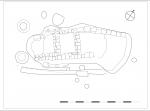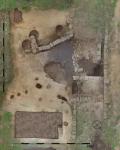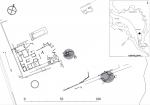Summary (English)
The 2018 excavations concentrated on the southern district of Veii (Piano, or Pian di Comunità), identifiable as the pottery making quarter of the Etruscan city and site of a sanctuary (not yet found). Two contexts were investigated (Fig. 1,a), situated on the south-eastern slopes of the plateau occupied by a building complex at 126 m a.s.l. The complex dates to the Republican-imperial period.
1) Trench 19 (Fig.1, b; 2) included a series of activities in negative in the bedrock. Postholes relating to a hut structure, two rubbish pits and a pit-silo were the earliest features, datable to the 8th century B.C. The creation of an elongated vat, flanked by a tunnel probably dates to a later phase within the 6th century B.C. Cut following the direction of the slope, the bottom of the vat was cut to form steps. On the downhill side of the vat, a sloped ramp provided access and on the north side, it was faced with a wall in Greek-style opus quadratum. The vat was filled by a series of dumps incorporating rubble from structures in tufa blocks, terracotta elements from a phase 1roof (including L – shaped cyme with white on red decoration) and abundant pottery. At the same phase as the fill, the cavity was used for the construction of a small building divided into three parts, whose floors were not preserved. The 2018 excavations showed that the vat was filled after the late 4th – early 3rd century B.C., and the tunnel went out of use at the same time. A substantial quantity of reconstructable pottery was recovered including jugs and small plates in plain depurated ware; jars of various shapes (one of which bearing an Etrusco-Latin inscription), and lids in red-brown impasto and internal slip ware; red and black glaze cups, in addition to fragments of figured Etruscan and sovradipinto vases. The presence of misfired and deformed examples indicates that pottery production continued after the city was taken by Rome.
2) Trench 25 (Fig. 1, C; 3) includes a seasonal craft working area that was active between the late 7th and the 5th century B.C., also created in an area previously occupied by huts, situated along the line of a deep road cut. The context includes small circular kilns (Cuomo di Caprio type 1b), a large rectangular cistern and cavities with diverse functions. The production structures are associated with an imposing series of charcoal dumps containing a substantial amount of pottery fragments, almost all from bucchero vessels – mostly reconstructable and over-fired – and fragments of objects made of refractory terracotta (rods, domes and small channels), which certainly related to its production cycle.
The 2018 excavations showed that the dumps not only filled the cavities formed by the progressive exploitation of the bedrock, but also the deepest part of the road cut. An outstanding find, a mould for a gorgon mask applique, was recovered among the abundant quantity of bucchero fragments from standardised forms.
- Laura Maria Michetti- Sapienza Università di Roma, Dipartimento Scienze dell’Antichità
- Barbara Belelli Marchesini- Sapienza Università di Roma, Dipartimento Scienze dell’Antichità
Director
- Gilda Bartoloni - Università di Roma
- Giovanni Colonna - Università degli Studi di Roma “La Sapienza”, Dipartimento di Scienze Storiche, Archeologiche, Antropologiche dell’Antichità – Sezione di Etruscologia
Team
- Andrea Di Napoli - Sapienza Università di Roma
- Chiara Mottolese - Sapienza Università di Roma
- Elisa Biancifiori - Università “La Sapienza” di Roma
- Enrico Sartini - Università La Sapienza di Roma
- Falco Biagi - Sapienza Università di Roma
- Jacopo Tabolli - Sapienza Università di Roma
- Laura Sagripanti - Università La Sapienza di Roma
- Luca Pulcinelli - Sapienza Università di Roma
- Matteo Miletti - Sapienza Università di Roma
- Orlando Cerasuolo - Sapienza Università di Roma
- Vilma Basilissi - Istituto Superiore per la Conservazione e il Restauro
- Alessandra Celant – Università degli studi “La Sapienza” di Roma
- Donata Sarracino - Sapienza Università di Roma, Dip. Scienze dell’Antichità
- Sara Neri - Sapienza Università di Roma
- Valeria Acconcia - Sapienza Università di Roma
Research Body
- Sapienza Università di Roma






![Download [PDF]](/excavation/skins/fasti/images/results/download_sml.png)

